This site contains affiliate links. I may receive a commission for purchases made through these links. As an Amazon Associate I earn from qualifying purchases. Read More
What you can see during a day visit to Hiroshima
I have not yet been to Japan but it is on my list as I really want to see the Snow Monkeys and Cherry Blossom. Hiroshima looks like a wonderful place to visit when travelling in Japan so I will definitely add it to my intinerary.
My friend and fellow traveller has however been to Japan and here she shares her experience of a day visit to Hiroshima whilst she was on a cruise. I think when I visit I might plan to have a couple of days to explore Hiroshima.

“Hiroshima is the capital of Hiroshima Prefecture and the largest city in the Chūgoku region of western Honshu – the largest island of Japan. The city’s name, 広島, means “Broad Island” in Japanese” (Source : Wikipeadia)
Here is her story of what she got up to during a day visit to Hiroshima
The tour of Hiroshima was booked with a cruise. I did not want to miss anything and doubted my ability to catch the necessary local transport due to the unforgiving Japanese written and spoken language and I wasn’t sure how widespread English was spoken.
Started at Peace Park
It was only a short coach ride to the Peace Park and we were issued with a commentary pack of a battery and headphones so that we could listen to the tour guide throughout the tour.
The first part of the Peace Park we visited was the Atomic Bomb Dome. This is the most iconic symbol of the events on August 6th 1945. I was surprised how emotional I felt standing there taking photos of it whilst listening to the commentary being given by the tour guide.
Next was the Children’s Peace Monument which was built to commemorate the thousands of children who died. One young girl called Sadako Sasaki was two years old when she was exposed to the radiation and died ten years later from leukaemia.
During her illness, she made folded paper cranes believing that if she folded a thousand paper cranes she would be cured but died before finishing them.
She is featured on top of the monument holding a metal crane. The folded paper crane continues to symbolizing the pursuit of peace and are still being sent to the monument from all over the world. The paper cranes are displayed in glass display cases around the monument.

Then we moved to the Flame of Peace which is designed in the image of two hands pressed together with the palms facing the sky. The flame was first lit on 1st August 1964 with the intention that it will continue to burn until nuclear weapons are abolished worldwide.
Further along is the Cenotaph for Atomic Bomb Victims which has the names of all those who lost their lives inscribed inside the central stone vault and is continually being updated.
Finally, we got to the Hiroshima Peace Memorial Museum. It was opened in 1955 and displays possessions from the victims of the bomb, photographs, and other documentation. Surprisingly you are allowed to take photographs inside the museum.
I found it very interesting and thought provoking. I know that a lot of children were killed because those aged over 12 were made to work in factories and demolition (because of the labour shortage) but very few exhibits focused on the adults who were killed.
I felt that my emotions were unnecessarily being manipulated. That being said it was a worthwhile visit.
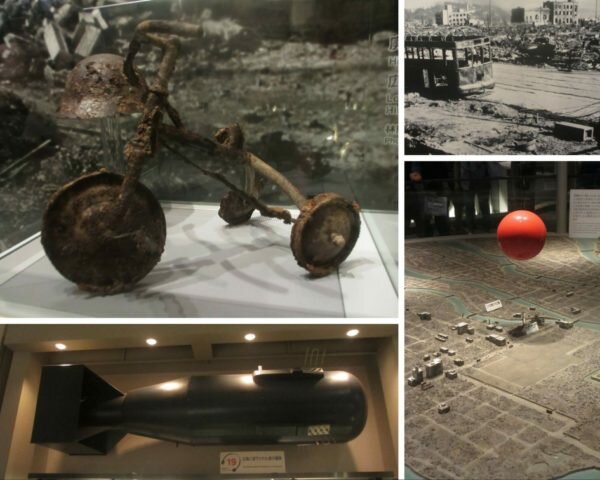
Miyajima Island
Back on the coach we made our way towards Miyajima Island. Now I know you could save money doing the trip yourself but as well as being stress free you also get the bonus of the tour guide giving you an insight of the day to day lives of the locals as we whizzed past. I feel that it is important to at least take an interest in such matters and for me it makes the tour so much more interesting.
Off the coach and time to get onto the ferry across to Miyajima Island. The Torii gate of the Shrine greets you like a big set of red ruby goals as you approach the island. It is set in the water so that high tide it gives the impression that it floats on the water. Unfortunately, it was being restored on my visit so my photos have scaffolding around the base of it.
As soon as you get off the ferry you are met with notice boards advising you that the local deer are wild. ‘What deer?’ I thought. Only to be nuzzled by one such deer on the lookout for a free feed! Then realised that they were everywhere!!!
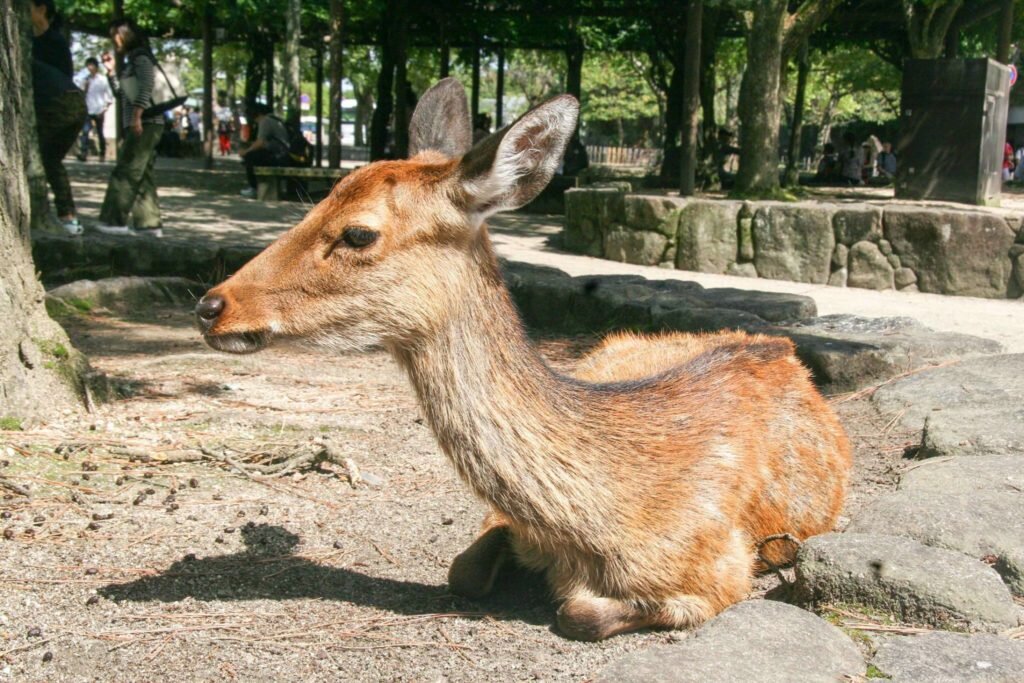
Lunch was included in this Hiroshima Tour
We were ushered along to the restaurant where we were to have our traditional Japanese lunch. I was really looking forward to sampling this and I wasn’t disappointed. The meal consisted of (left to right)
- Miso vegetable soup
- Cuttlefish, Tuna, fried chicken, noodles, cabbage and wasabi
- Plain boiled rice
- Cucumber, spring onion, baby octopus and squid.
- Seaweed and dried shrimp
- Pickled vegetables
- Soy sauce
If you are in Hiroshima a local dish to try is Hiroshima okonomiyaki which is a savory pancake filled with vegetables, seafood and meat it sounds delicious.
Itsukushima Shrine
Sufficiently fed it was time to have a wander around the Itsukushima Shrine. At the entrance to shrine there is cleansing water which you are encouraged to wash your hands with prior to entering the shrine.
The brilliant red shrine complex consists of multiple buildings supported on pillars above the sea and connected to each other by boardwalks.
Like the Torri gate at high tide the whole shrine complex appears to float on the water. I was surprised to see barrels of Sake being displayed along one of the boardwalks but other than that one building looked very much like another.
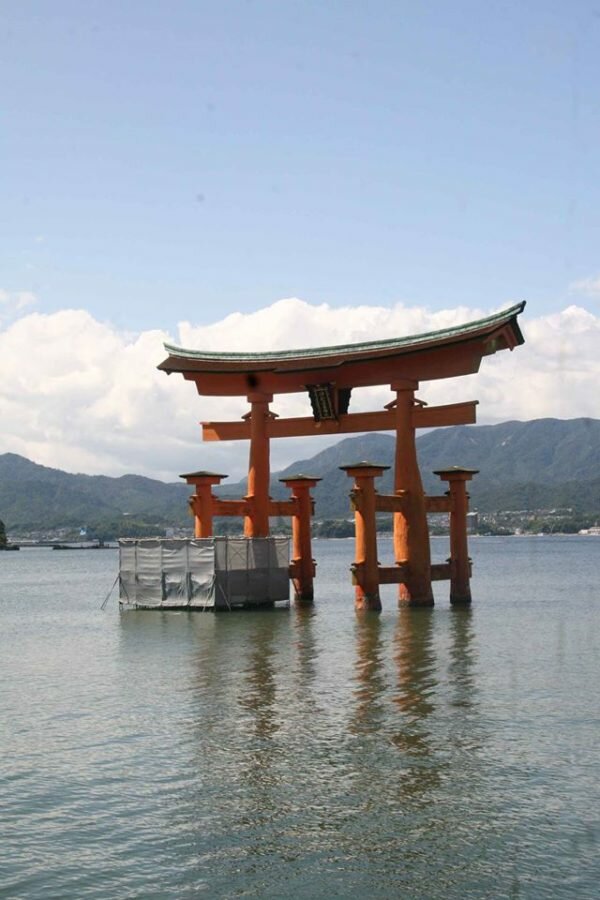
Leaving the shrine, we wandered around the shopping area where there were lots of souvenir shops, restaurants and many stalls selling oysters for which the island is famous for. The oysters are just simply grilled in their shells and served. I didn’t try the oysters as I had just eaten and I also thought there were quite expensive.
I would have had a go on a rickshaw pulled by a suitably dressed young man but hubby wasn’t having any of it so I missed out on that little treat as I didn’t want to do it on my own.
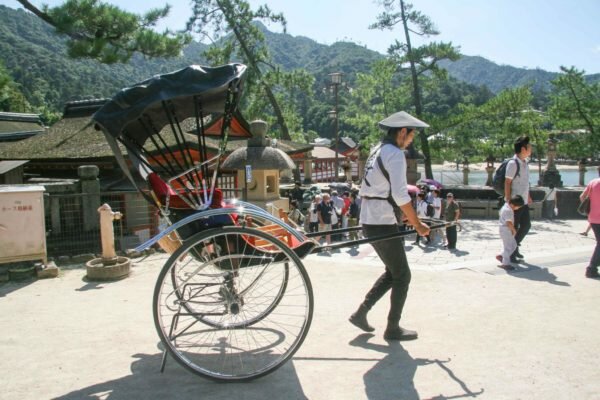
Soon it was time to leave and return to the cruise ship. It had been a lovely day but was slightly disappointed that I hadn’t had the opportunity to see a traditionally dressed Japanese lady. Then suddenly I saw a young couple walking along the street in traditional dress. I wanted a photo but wasn’t brazen enough to walk up to them and ask so I became a stalker!!
I fixed my long lens on the camera and spent ages trying to get ‘the shot’ without being too obvious about it.
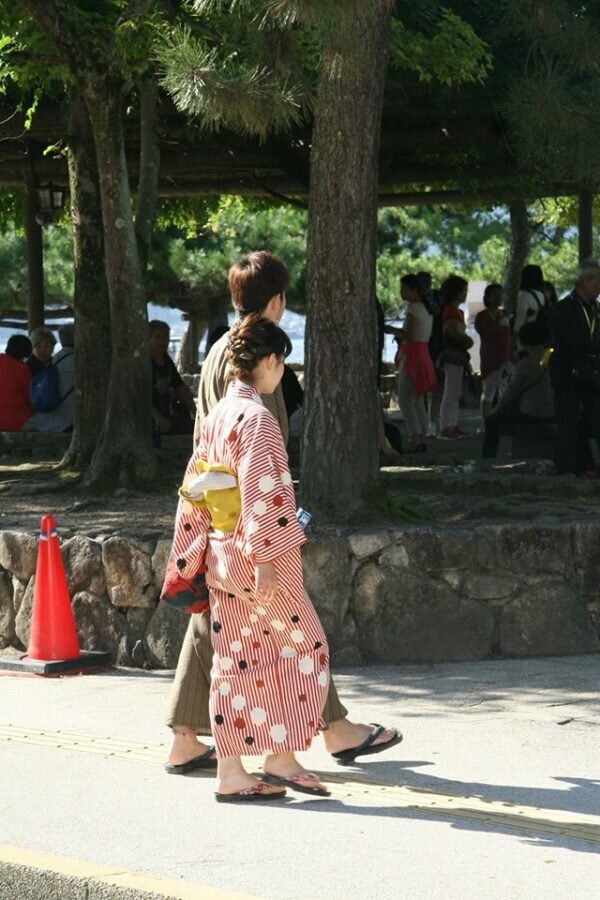
When we got back to port there was the usual stalls selling goods and souvenirs but I was delighted to see a group of Japanese women with rails of Kimono robes. They were dressing people in the robes and allowing them to take their own photos of themselves wearing the kimonos. Moreover, they were doing it free of charge!!!
Hubby wasn’t the slightest bit interested so he left me and got on the ship. I spent ages watching it all going on. I began offering to take photos of the people using their camera/phone so that they got a nice photo rather than a selfie style one. Suddenly I found myself being handed cameras and phones by everyone – no language barrier there!!!
Eventually the eldest dresser approached me, took me by the hand and walked me to the rail containing the kimonos. She selected one (which happened to be my favourite of those there) and began dressing me. Whilst other people were coming and going in a quick production line – she took her time with me, she fussed, readjusted, and readjusted again. She took a full 15 minutes or more to dress me. It was a wonderful experience rather than just a photo opportunity. I loved every minute of it.
If you like reading this article then please share. If you are visiting Hiroshima soon then how about pinning for future reference




